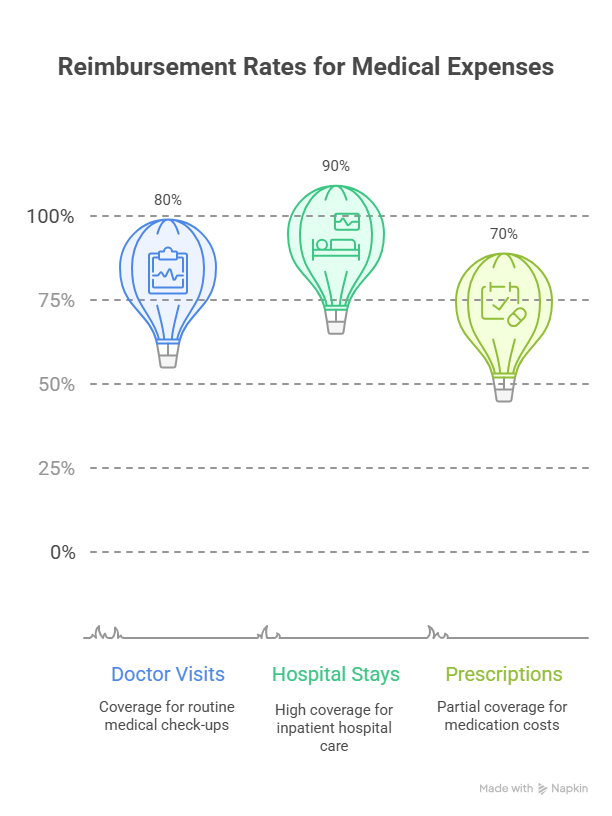Millions of Americans lose out on thousands of dollars in medical reimbursements every year; did you know that? Understanding the steps involved can make all the difference, but navigating the process can be intimidating.
It is anticipated that the medical reimbursement application process will become more efficient in 2025, with new regulations and online resources making it simpler for people to submit their claims. This post will explain the required paperwork and take you step-by-step through the entire procedure.
After reading this guide, you will have the skills necessary to submit your medical reimbursement claims successfully and get the most money possible.
Understanding Medical Reimbursements in 2025
It is essential to comprehend the reimbursement procedure as we negotiate the intricacies of medical costs in 2025. A key component of controlling healthcare expenses is medical reimbursements, and people can maximize their benefits by keeping up with the most recent advancements.As we navigate the complexities of medical expenses in 2025, understanding the reimbursement process is crucial. Medical reimbursements are an essential aspect of managing healthcare costs, and staying informed about the latest developments can help individuals make the most of their benefits.
Key Changes in the 2025 Reimbursement System
A number of significant changes have been made to the 2025 reimbursement system. These include expedited claim processing and increased coverage for specific medical procedures. Comprehending these modifications is essential to optimizing your reimbursement advantages.
Types of Medical Expenses Eligible for Reimbursement
In 2025, a range of medical costs may be reimbursed. These consist of prescription drugs, hospital stays, doctor visits, and specific medical equipment. Some typical eligible expenses are listed in the following table:
| Expense Type | Eligibility | Reimbursement Rate |
|---|---|---|
| Doctor Visits | Yes | 80% |
| Hospital Stays | Yes | 90% |
| Prescriptions | Yes | 70% |

Before You Begin: Eligibility Requirements
Individuals must fulfill specific requirements, such as being enrolled in a qualifying health plan and reaching certain income thresholds, in order to be eligible for medical reimbursement in 2025. Before submitting a claim, it is imperative to review these requirements.To be eligible for medical reimbursement in 2025, individuals must meet certain requirements, including being enrolled in a qualifying health plan and meeting specific income thresholds. It’s essential to review these requirements before filing a claim.
How to File Medical Reimbursement: Step-by-Step Process
Effectively navigating the medical claims submission guide is crucial to receiving reimbursement for medical expenses. There are a number of steps in this process that, when properly completed, guarantee a seamless experience. By being aware of the requirements and procedures, you can steer clear of typical problems.To get reimbursed for medical expenses, it’s essential to navigate the medical claims submission guide effectively. This process involves several steps that, when followed correctly, ensure a smooth experience. By understanding the requirements and procedures, you can avoid common pitfalls.
Essential Documents You’ll Need
The first step in submitting a medical reimbursement claim is to collect the required documentation. This includes all of the documents that back up your claim. The process is streamlined when all the documents are prepared.Gathering the necessary documents is the first step in filing a medical reimbursement claim. This includes various paperwork that supports your claim. Having all documents ready streamlines the process.
Medical Bills and Itemized Receipts
Since they offer comprehensive details about the medical services received and the related expenses, medical bills and itemized receipts are essential. Make sure all pertinent information is included and that these documents are readable.
Proof of Payment Documentation
To confirm that the medical costs were covered, proof of payment is required. Some examples of this include credit card statements, bank statements, and receipts that have been marked as “paid.”Proof of payment is necessary to verify that the medical expenses were paid. This can include bank statements, credit card statements, or receipts marked “paid.”
Insurance Information and Explanation of Benefits
You will need to present the Explanation of Benefits (EOB) statement and your insurance information if you have health insurance. Your insurance’s coverages and exclusions are detailed in the EOB.If you have health insurance, you’ll need to provide your insurance information and the Explanation of Benefits (EOB) statement. The EOB outlines what your insurance covers and what it doesn’t.
Completing the Reimbursement Forms Correctly
Accurately completing the medical reimbursement forms is essential. Verify that all required fields have been filled out and look for any mistakes or omissions. Giving accurate information speeds up the claim processing process.
Submission Options: Digital vs. Paper Filing
You have two options for submitting your medical reimbursement claim: electronically or on paper. While paper filing can be helpful if you prefer a physical record or don’t have access to digital tools, digital filing is typically quicker and more convenient.
Tracking Your Claim and Processing Timeframes
It’s critical to monitor the status of your claim after submitting it. You can check the status online or by calling a customer service number on the majority of reimbursement systems. You can make plans and follow up as needed if you are aware of the processing timeframes.
Conclusion
In 2025, submitting a medical reimbursement claim requires assembling the required paperwork and comprehending the reimbursement procedure. People can guarantee a seamless and effective experience by adhering to the specified procedures.
Following the guidelines for medical billing and reimbursement given by the appropriate authorities is essential to a successful claim. This entails filling out reimbursement forms precisely and sending in the necessary paperwork on time.
People can confidently handle the medical reimbursement process and make sure they get the reimbursement they are entitled to if they are well-informed and prepared.
FAQ
What is the deadline for filing a medical reimbursement claim in 2025?
In 2025, you usually have 180 days from the date of the medical service or treatment to submit a medical reimbursement claim. For precise deadlines, it’s best to inquire with your insurance company or human resources department.
What types of medical expenses are eligible for reimbursement?
Prescription drugs, hospital stays, doctor visits, medical equipment, and other associated costs are all considered medical expenses. Alternative therapies like chiropractic adjustments or acupuncture may also be covered by certain insurance plans.
How do I track the status of my medical reimbursement claim?
If you’re filing through your employer, you can check with your HR representative, contact your insurance provider’s customer service department, or log into their online portal to see the status of your claim.
Can I file a medical reimbursement claim for expenses incurred outside the United States?
The policies of your insurance plan will determine this. International medical costs may be covered by some plans but not by others. To find out if you qualify for reimbursement, review the documentation for your plan or get in touch with your insurance company.
What is the medical reimbursement process for employees?
Usually, the medical reimbursement procedure entails sending a claim form to your employer or insurance company along with the necessary paperwork, including medical bills and proof of payment. After that, they will examine and handle your claim in accordance with their policies.
How long does it take to process a medical reimbursement claim?
Processing times differ based on the employer or insurance company. The processing time for a claim can typically range from a few days to several weeks. For an estimate of processing times, contact your provider.
What are the common reasons for medical reimbursement claim denials?
Claim denials frequently occur for a variety of reasons, such as missing documentation, non-covered services, incomplete or erroneous claim forms, or exceeding the maximum reimbursement limit. The chance of your claim being rejected can be reduced by carefully reviewing it before submitting it.Common reasons for claim denials include incomplete or inaccurate claim forms, missing documentation, non-covered services, or exceeding the maximum reimbursement limit. Reviewing your claim carefully before submission can help minimize the risk of denial.
Can I appeal a denied medical reimbursement claim?
Yes, you can usually appeal a claim that has been rejected by providing more details or explanation to back it up. Find out the appeals procedure and necessary paperwork from your insurance company or human resources department.




